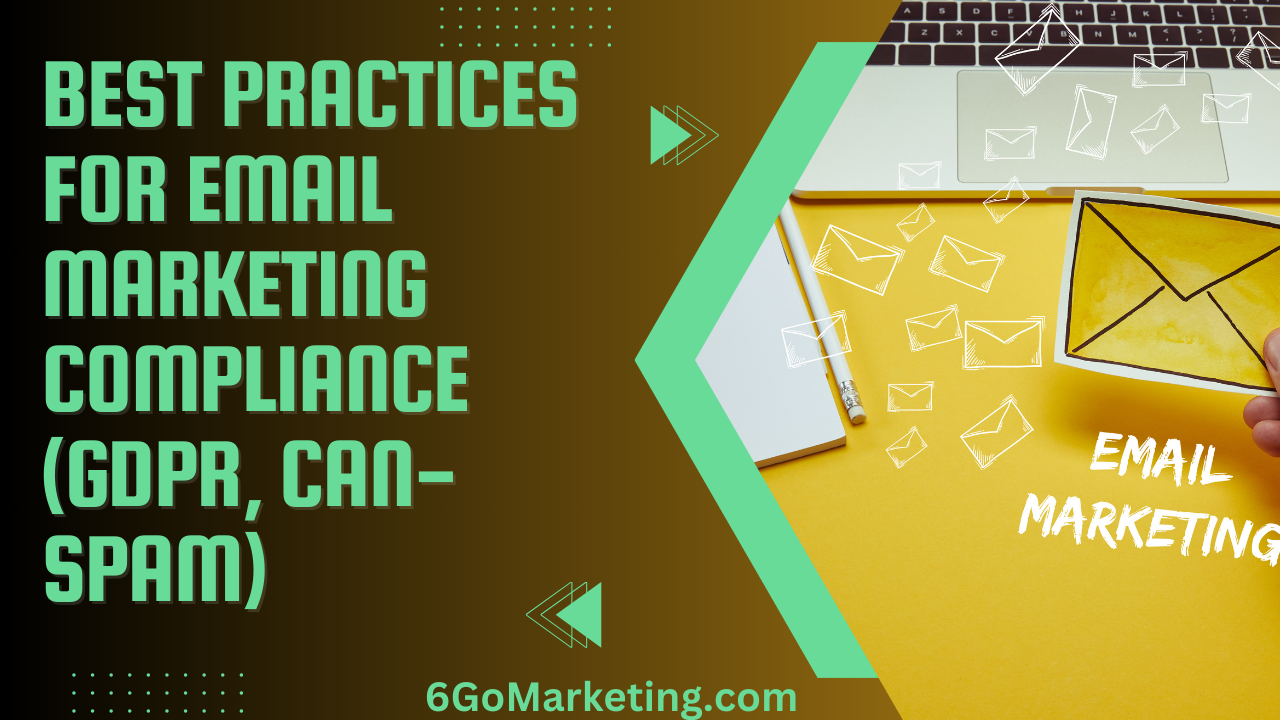Email marketing is one of the most powerful tools for businesses to connect with their customers, promote products, and drive sales. However, with the increasing focus on data privacy and protection, it’s crucial to ensure that your email marketing practices comply with regulations such as the General Data Protection Regulation (GDPR) and the CAN-SPAM Act. Non-compliance can lead to significant fines, damage to your brand’s reputation, and loss of customer trust.
In this comprehensive guide, we’ll explore the best practices for email marketing compliance, focusing on GDPR and CAN-SPAM. By following these guidelines, you can ensure that your email marketing efforts, whether managed in-house or through a digital marketing consultant, are both effective and legally compliant.
Understanding GDPR and CAN-SPAM
Before diving into the best practices, it’s important to understand what GDPR and CAN-SPAM are and how they impact email marketing.
What is GDPR?
The General Data Protection Regulation (GDPR) is a regulation implemented by the European Union (EU) that came into effect on May 25, 2018. GDPR is designed to protect the privacy and personal data of individuals within the EU. It applies to any organization that processes the personal data of EU residents, regardless of where the organization is located.
Key aspects of GDPR relevant to email marketing include:
- Consent: Organizations must obtain explicit consent from individuals before sending them marketing emails.
- Data Subject Rights: Individuals have the right to access, correct, and delete their personal data, as well as to withdraw consent at any time.
- Data Minimization: Only the minimum amount of personal data necessary for the purpose should be collected and processed.
- Transparency: Organizations must be transparent about how they collect, use, and store personal data.
What is CAN-SPAM?
The CAN-SPAM Act (Controlling the Assault of Non-Solicited Pornography and Marketing) is a U.S. law that was enacted in 2003 to regulate commercial email messages. The law sets requirements for commercial emails, establishes penalties for violations, and gives recipients the right to have you stop emailing them.
Key aspects of CAN-SPAM relevant to email marketing include:
- Identification: Emails must clearly identify the sender and include a valid physical postal address.
- Opt-Out Mechanism: Emails must provide a clear and easy way for recipients to opt out of receiving future emails.
- Honesty in Subject Lines: Subject lines must not be misleading or deceptive.
- Prompt Compliance: When a recipient opts out, you must honor their request within 10 business days.
Best Practices for Email Marketing Compliance
Now that we have a basic understanding of GDPR and CAN-SPAM, let’s explore the best practices for ensuring your email marketing campaigns comply with these regulations.
Utilizing whistleblowing software can also be an essential part of maintaining compliance, as it allows organizations to report and address any violations of these regulations confidentially.
1. Obtain Explicit Consent
One of the most critical aspects of GDPR compliance is obtaining explicit consent from individuals before sending them marketing emails. Consent must be freely given, specific, informed, and unambiguous.
How to Obtain Consent
- Opt-In Forms: Use opt-in forms on your website, where individuals can actively choose to subscribe to your email list. Avoid pre-ticked checkboxes or any form of implied consent.
- Double Opt-In: Implement a double opt-in process, where subscribers receive a confirmation email and must click a link to confirm their subscription. This adds an extra layer of consent and ensures that the individual genuinely wants to receive your emails.
- Clear Language: Clearly explain what individuals are consenting to, including the types of emails they will receive and how their data will be used.
- Granular Consent: If you plan to send different types of emails (e.g., newsletters, promotional offers, event invitations), provide separate checkboxes for each type of content so subscribers can choose what they want to receive.
Example of a Compliant Opt-In Form:
| Field | Description |
|---|---|
| Email Address | [Text Box] |
| Subscribe to Newsletter | [Checkbox] Yes, I want to receive the monthly newsletter. |
| Receive Promotions | [Checkbox] Yes, I want to receive special offers and promotions. |
| Event Invitations | [Checkbox] Yes, I want to be invited to upcoming events. |
2. Provide Clear Opt-Out Mechanisms
Both GDPR and CAN-SPAM require that you provide recipients with a clear and easy way to opt out of receiving future emails. Failure to comply with opt-out requests can result in significant penalties.
Best Practices for Opt-Out Mechanisms
- Unsubscribe Link: Include a prominent unsubscribe link in every email you send. The link should be easy to find and labeled clearly, such as “Unsubscribe” or “Manage Preferences.”
- Preference Center: Instead of offering a simple unsubscribe option, consider creating a preference center where recipients can choose which types of emails they want to receive. This can reduce the likelihood of a full opt-out while respecting the recipient’s preferences.
- Immediate Action: When a recipient opts out, their request should be processed immediately, and they should be removed from your email list within 10 business days, as required by CAN-SPAM.
- No Barriers: Ensure that the opt-out process is straightforward and doesn’t require the recipient to log in or navigate through multiple pages.
Quote: “Providing a clear and easy way to opt out is not just a legal requirement—it’s a sign of respect for your subscribers’ preferences.” — Jane Doe, Email Marketing Expert
3. Be Transparent About Data Usage
Transparency is a key requirement of GDPR. You must inform individuals about how their personal data will be used, stored, and shared. This builds trust and ensures that you comply with the regulation.
How to Ensure Transparency
- Privacy Policy: Include a link to your privacy policy in your emails and on your opt-in forms. Your privacy policy should clearly outline how you collect, use, and protect personal data.
- Data Collection: Clearly inform subscribers what data you are collecting and why. For example, explain why you need their email address and how it will be used.
- Third-Party Sharing: If you share personal data with third parties (e.g., for analytics or marketing purposes), be transparent about this and provide details on who these third parties are.
- Right to Access and Delete: Inform subscribers of their rights under GDPR, including the right to access, correct, or delete their personal data.
Example of a Privacy Policy Statement:
| Statement | Description |
|---|---|
| Data Collection | We collect your email address to send you newsletters and promotional offers. |
| Data Usage | Your data will be used exclusively for sending emails related to [Company Name]. We will not share your data with third parties without your consent. |
| Right to Access and Delete | You have the right to request access to your data, correct any inaccuracies, or request deletion of your data at any time. |
4. Keep Accurate Records of Consent
GDPR requires that you maintain records of consent to demonstrate compliance. This includes documenting when, where, and how consent was obtained.
How to Keep Accurate Records
- Timestamped Records: Store records of when and where each subscriber gave consent. This can include the date and time of subscription, the IP address, and the specific form or method used to obtain consent.
- Audit Trails: Maintain an audit trail that tracks any changes to consent, such as updates to a subscriber’s preferences or the withdrawal of consent.
- Data Management Tools: Use CRM or email marketing software that allows you to track and manage consent records easily.
Quote: “Maintaining accurate records of consent is crucial for demonstrating compliance with GDPR and protecting your business from potential fines.” — John Smith, Data Protection Officer
5. Use Honest and Clear Subject Lines
Under CAN-SPAM, the subject line of your emails must accurately reflect the content of the message. Misleading or deceptive subject lines are prohibited and can result in penalties.
Best Practices for Subject Lines
- Be Honest: Ensure that your subject line accurately describes the content of the email. For example, if your email is about a sale, the subject line should reflect that, such as “Save 20% on Your Next Purchase.”
- Avoid Clickbait: Refrain from using clickbait tactics, such as “You Won’t Believe This Offer!” unless the content genuinely matches the excitement promised.
- Keep It Relevant: Tailor your subject lines to the interests and preferences of your audience. This not only ensures compliance but also increases the likelihood of your emails being opened.
Examples of Compliant Subject Lines:
| Subject Line | Email Content Description |
|---|---|
| “Exclusive: 20% Off Your Favorite Products” | Promotional email offering a discount on products the recipient has previously purchased. |
| “Webinar Invitation: Learn How to Improve Your Marketing Strategy” | Email invitation to a marketing webinar. |
| “Monthly Newsletter: October Edition” | Newsletter containing updates, articles, and offers for the month of October. |
6. Include Your Physical Mailing Address
Both GDPR and CAN-SPAM require that you include a valid physical mailing address in your emails. This requirement ensures transparency and provides recipients with a way to contact your business, which is essential for maintaining trust and compliance.
How to Include Your Mailing Address
- Email Footer: Place your physical mailing address in the footer of every email. This location is standard practice and ensures that the information is easily accessible without being intrusive.
- Consistent Formatting: Use a consistent format for your mailing address across all emails to maintain a professional appearance. Include your company name, street address, city, state, and postal code.
- Updated Information: Regularly review and update your mailing address information, especially if your business relocates. An outdated address can not only cause compliance issues but also lead to a loss of trust with your recipients.
Example of an Email Footer with Mailing Address:
| Footer Content | Example |
|---|---|
| Company Name | XYZ Corporation |
| Physical Address | 123 Main Street, Suite 500, Anytown, USA 12345 |
| Unsubscribe Link | [Unsubscribe] |
| Privacy Policy Link | [Privacy Policy] |
7. Segment Your Email List
Segmentation is a powerful strategy that not only improves the relevance of your emails but also enhances compliance with GDPR and CAN-SPAM regulations. By segmenting your email list, you can tailor your messages to different groups within your audience, ensuring that your communications are more targeted and less likely to be marked as spam.
Benefits of Segmentation
- Relevance: Sending targeted emails that are relevant to the recipient increases engagement rates and reduces the likelihood of unsubscribes.
- Improved Compliance: By segmenting your list based on consent and preferences, you can ensure that you are only sending emails to those who have opted in to receive specific types of content.
- Reduced Spam Complaints: Targeted emails are less likely to be perceived as spam, reducing the risk of spam complaints and improving your sender reputation.
How to Segment Your List
- Behavioral Data: Segment your list based on how recipients interact with your emails, such as open rates, click-through rates, and purchase history.
- Demographics: Use demographic information, such as age, location, and gender, to create segments that allow for more personalized messaging.
- Engagement Level: Separate active subscribers from inactive ones. Consider re-engagement campaigns for those who haven’t interacted with your emails in a while.
- Preferences: Allow subscribers to specify their content preferences, and segment your list accordingly. For example, some subscribers may prefer product updates, while others are more interested in educational content.
Table: Example of Segmentation Criteria
| Segment Type | Criteria | Example Email Content |
|---|---|---|
| Recent Purchasers | Customers who made a purchase within the last 30 days | Product care tips and related product recommendations |
| Inactive Subscribers | Subscribers who haven’t opened an email in 90 days | Re-engagement campaign with a special offer |
| Location-Based | Subscribers in a specific region | Event invitations or location-specific promotions |
| Interest-Based | Subscribers who expressed interest in specific topics | Content tailored to their expressed interests |
8. Regularly Clean Your Email List
Maintaining a clean email list is essential for compliance, deliverability, and engagement. An outdated or poorly managed email list can lead to high bounce rates, spam complaints, and legal risks under GDPR and CAN-SPAM.
Best Practices for List Cleaning
- Remove Hard Bounces: Regularly monitor your email campaigns for hard bounces (emails that cannot be delivered due to invalid addresses) and remove these addresses from your list.
- Manage Inactive Subscribers: Identify subscribers who haven’t engaged with your emails in a specified period (e.g., six months) and consider removing them from your list or sending a re-engagement campaign to confirm their interest.
- Confirm Consent: For older lists, especially those acquired before GDPR came into effect, consider running a re-permission campaign to confirm consent. This ensures that you are only emailing individuals who have explicitly opted in.
- Monitor Engagement Metrics: Keep an eye on your open and click-through rates. Low engagement can indicate that your list needs to be cleaned or that your content needs to be adjusted to better meet your audience’s needs.
Quote: “A smaller, engaged list is far more valuable than a large, unengaged one. Regular list cleaning is key to maintaining high deliverability and compliance.” — Mark Johnson, Email Marketing Specialist
9. Monitor and Analyze Your Email Campaigns
Continuous monitoring and analysis of your email campaigns are critical for ensuring compliance and optimizing performance. By regularly reviewing your campaign metrics, you can identify potential issues and areas for improvement.
Key Metrics to Monitor
- Open Rates: Measure the percentage of recipients who open your emails. Low open rates may indicate issues with subject lines, sender reputation, or list quality.
- Click-Through Rates (CTR): Track how many recipients click on links within your emails. This metric helps you gauge the effectiveness of your content and calls to action.
- Unsubscribe Rates: Monitor the rate at which recipients unsubscribe from your emails. A high unsubscribe rate may indicate that your content is not meeting subscribers’ expectations or that you are sending too frequently.
- Spam Complaints: Keep an eye on the number of recipients marking your emails as spam. High spam complaint rates can damage your sender reputation and lead to compliance issues.
- Bounce Rates: Track both soft bounces (temporary delivery issues) and hard bounces (permanent delivery issues) to maintain list hygiene.
Table: Example of Email Campaign Metrics
| Metric | Description | Ideal Range |
|---|---|---|
| Open Rate | Percentage of recipients who open the email | 15-25% (varies by industry) |
| Click-Through Rate | Percentage of recipients who click on a link | 2-5% (varies by industry) |
| Unsubscribe Rate | Percentage of recipients who unsubscribe | Less than 0.5% |
| Spam Complaint Rate | Percentage of recipients who mark email as spam | Less than 0.1% |
| Bounce Rate | Percentage of emails that fail to deliver | Less than 2% |
Adjusting Your Strategy
Based on your analysis, make data-driven adjustments to your email marketing strategy:
- A/B Testing: Experiment with different subject lines, content formats, and sending times to see what resonates best with your audience.
- Content Optimization: Refine your email content to align better with your audience’s interests and preferences. Consider varying content types, such as videos, infographics, and text-based emails.
- Frequency Management: Adjust the frequency of your emails based on engagement metrics. If unsubscribe rates are high, consider reducing the frequency of your emails.
10. Train Your Team on Compliance
Ensuring compliance with GDPR, CAN-SPAM, and other relevant regulations requires that everyone involved in your email marketing efforts is well-informed and trained on best practices.
How to Train Your Team
- Regular Training Sessions: Conduct regular training sessions on email marketing compliance for all team members, especially those involved in content creation, data management, and campaign execution.
- Compliance Checklists: Provide your team with compliance checklists that outline the key steps and requirements for each campaign. This ensures that nothing is overlooked.
- Updates on Regulations: Keep your team informed about any updates or changes in regulations that may affect your email marketing practices. Regular briefings or newsletters can help with this.
- Role-Specific Training: Tailor training sessions to the specific roles within your team. For example, your legal team may need detailed information on data protection laws, while your marketing team needs to focus on content compliance.
Quote: “Compliance isn’t just a one-time task; it’s an ongoing commitment that requires continuous education and vigilance.” — Sarah Green, Compliance Officer
Conclusion
Email marketing compliance is not just about avoiding fines or legal issues—it’s about building trust with your audience and ensuring that your communications are respectful and relevant. By following these best practices for GDPR and CAN-SPAM compliance, you can protect your business, enhance your brand reputation, and create more effective email marketing campaigns.
Remember, the landscape of email marketing regulations is constantly evolving, so it’s essential to stay informed and proactive. Regularly review your practices, train your team, and monitor your campaigns to ensure that you remain compliant and continue to build strong, lasting relationships with your subscribers.










